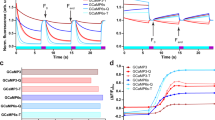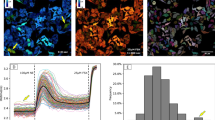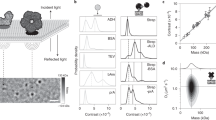Abstract
Label-free dynamic mass redistribution (DMR) is a cutting-edge assay technology that enables real-time detection of integrated cellular responses in living cells. It relies on detection of refractive index alterations on biosensor-coated microplates that originate from stimulus-induced changes in the total biomass proximal to the sensor surface. Here we describe a detailed protocol to apply DMR technology to frame functional behavior of G protein–coupled receptors that are traditionally examined with end point assays on the basis of detection of individual second messengers, such as cAMP, Ca2+ or inositol phosphates. The method can be readily adapted across diverse cellular backgrounds (adherent or suspension), including primary human cells. Real-time recordings can be performed in 384-well microtiter plates and be completed in 2 h, or they can be extended to several hours depending on the biological question to be addressed. The entire procedure, including cell harvesting and DMR detection, takes 1–2 d.
This is a preview of subscription content, access via your institution
Access options
Subscribe to this journal
Receive 12 print issues and online access
$259.00 per year
only $21.58 per issue
Buy this article
- Purchase on Springer Link
- Instant access to full article PDF
Prices may be subject to local taxes which are calculated during checkout










Similar content being viewed by others
References
Overington, J.P., Al-Lazikani, B. & Hopkins, A.L. How many drug targets are there? Nat. Rev. Drug Discov. 5, 993–996 (2006).
Galandrin, S., Oligny-Longpre, G. & Bouvier, M. The evasive nature of drug efficacy: implications for drug discovery. Trends Pharmacol. Sci. 28, 423–430 (2007).
Kenakin, T. & Miller, L.J. Seven transmembrane receptors as shapeshifting proteins: the impact of allosteric modulation and functional selectivity on new drug discovery. Pharmacol. Rev. 62, 265–304 (2010).
Rajagopal, S., Rajagopal, K. & Lefkowitz, R.J. Teaching old receptors new tricks: biasing seven-transmembrane receptors. Nat. Rev. Drug Discov. 9, 373–386 (2010).
Kenakin, T. Collateral efficacy in drug discovery: taking advantage of the good (allosteric) nature of 7TM receptors. Trends Pharmacol. Sci. 28, 407–415 (2007).
Prezeau, L. et al. Functional crosstalk between GPCRs: with or without oligomerization. Curr. Opin. Pharmacol. 10, 6–13 (2010).
Fang, Y., Ferrie, A.M., Fontaine, N.H., Mauro, J. & Balakrishnan, J. Resonant waveguide grating biosensor for living cell sensing. Biophys. J. 91, 1925–1940 (2006).
Kenakin, T. A holistic view of GPCR signaling. Nat. Biotechnol. 28, 928–929 (2010).
Kenakin, T.P. Cellular assays as portals to seven-transmembrane receptor-based drug discovery. Nat. Rev. Drug Discov. 8, 617–626 (2009).
Rocheville, M. & Jerman, J.C. 7TM pharmacology measured by label-free: a holistic approach to cell signalling. Curr. Opin. Pharmacol. 9, 643–649 (2009).
Scott, C.W. & Peters, M.F. Label-free whole-cell assays: expanding the scope of GPCR screening. Drug Discov. Today 15, 704–716 (2010).
Ciambrone, G.J. et al. Cellular dielectric spectroscopy: a powerful new approach to label-free cellular analysis. J. Biomol. Screen 9, 467–480 (2004).
Fang, Y. Non-invasive optical biosensor for probing cell signaling. Sensors 7, 2316–2329 (2007).
Giaever, I. & Keese, C.R. A morphological biosensor for mammalian cells. Nature 366, 591–592 (1993).
Antony, J. et al. Dualsteric GPCR targeting: a novel route to binding and signaling pathway selectivity. FASEB J. 23, 442–450 (2009).
Schmidt, J. et al. Conjugated linoleic acids mediate insulin release through islet G protein coupled receptor FFA1/GPR40. J. Biol. Chem. 286, 11890–11894 (2011).
Schmidt, J. et al. Selective orthosteric free fatty acid receptor 2 (FFA2) agonists: identification of the structural and chemical requirements for selective activation of FFA2 versus FFA3. J. Biol. Chem. 286, 10628–10640 (2011).
Schröder, R. et al. Deconvolution of complex G protein–coupled receptor signaling in live cells using dynamic mass redistribution measurements. Nat. Biotechnol. 28, 943–949 (2010).
Schröder, R. et al. The C-terminal tail of CRTH2 is a key molecular determinant that constrains Galphai and downstream signaling cascade activation. J. Biol. Chem. 284, 1324–1336 (2009).
Jiang, J. et al. Neuroprotection by selective allosteric potentiators of the EP2 prostaglandin receptor. Proc. Natl. Acad. Sci. USA 107, 2307–2312 (2010).
Niswender, C.M. et al. Context-dependent pharmacology exhibited by negative allosteric modulators of metabotropic glutamate receptor 7. Mol. Pharmacol. 77, 459–468 (2010).
Kostylina, G., Simon, D., Fey, M.F., Yousefi, S. & Simon, H.U. Neutrophil apoptosis mediated by nicotinic acid receptors (GPR109A). Cell Death Differ. 15, 134–142 (2008).
Atienza, J.M., Yu, N., Wang, X., Xu, X. & Abassi, Y. Label-free and real-time cell-based kinase assay for screening selective and potent receptor tyrosine kinase inhibitors using microelectronic sensor array. J. Biomol. Screen 11, 634–643 (2006).
Chen, J.Y., Li, M., Penn, L.S. & Xi, J. Real-time and label-free detection of cellular response to signaling mediated by distinct subclasses of epidermal growth factor receptors. Anal. Chem. 83, 3141–3146 (2011).
Fang, Y., Ferrie, A.M., Fontaine, N.H. & Yuen, P.K. Characteristics of dynamic mass redistribution of epidermal growth factor receptor signaling in living cells measured with label-free optical biosensors. Anal. Chem. 77, 5720–5725 (2005).
Codd, E.E., Mabus, J.R., Murray, B.S., Zhang, S.P. & Flores, C.M. Dynamic mass redistribution as a means to measure and differentiate signaling via opioid and cannabinoid receptors. Assay Drug Develop. Technol. 9, 362–372 (2011).
Azzi, M. et al. Beta-arrestin-mediated activation of MAPK by inverse agonists reveals distinct active conformations for G protein–coupled receptors. Proc. Natl. Acad. Sci. USA 100, 11406–11411 (2003).
Keese, C.R., Wegener, J., Walker, S.R. & Giaever, I. Electrical wound-healing assay for cells in vitro. Proc. Natl. Acad. Sci. USA 101, 1554–1559 (2004).
Peters, M.F., Vaillancourt, F., Heroux, M., Valiquette, M. & Scott, C.W. Comparing label-free biosensors for pharmacological screening with cell-based functional assays. Assay Drug Develop. Technol. 8, 219–227 (2009).
Christiansen, E. et al. Discovery of potent and selective agonists for the free fatty acid receptor 1 (FFA(1)/GPR40), a potential target for the treatment of type II diabetes. J. Med. Chem. 51, 7061–7064 (2008).
Mathiesen, J.M. et al. On the mechanism of interaction of potent surmountable and insurmountable antagonists with the prostaglandin D2 receptor CRTH2. Mol. Pharm. 69, 1441–1453 (2006).
Takasaki, J. et al. A novel Galphaq/11-selective inhibitor. J. Biol. Chem. 279, 47438–47445 (2004).
Sturm, G.J. et al. 5-Oxo-6,8,11,14-eicosatetraenoic acid is a potent chemoattractant for human basophils. J. Allergy Clin. Immunol. 116, 1014–1019 (2005).
Acknowledgements
We thank U. Rick, M. Vasmer-Ehses and T. Kögler for expert technical assistance and Corning for providing us with the Epic system. This work was supported by the DFG (Deutsche Forschungsgemeinschaft, German Research Foundation) grants KO 1582/3-1 to E.K. and MO 821/2-1 to K.M. D.K. is a member of the DFG-funded Research Training Group GRK 677, W.S. is a member of the NRW International Graduate Research School Biotech Pharma. We thank M. De Amici and U. Holzgrabe (University of Milan, Italy, and University of Würzburg, Germany) for kindly providing Hybrid 1 (ref. 15), T. Ulven (University of Southern Denmark, Denmark) for TM30089 (ref. 31) and TUG424 (ref. 30), and Astellas Pharma (Osaka, Japan) for providing us with YM-254890 (ref. 32).
Author information
Authors and Affiliations
Contributions
R.S., J.S., S.B., L.P., N.J., M.G., W.S., D.K. and N.M. designed and performed the experiments, C.D., J.G. and G.M. provided important ideas and edited the manuscript, E.K. and K.M. designed experiments and wrote the manuscript.
Corresponding authors
Ethics declarations
Competing interests
The Epic biosensor was provided to E.K. by Corning, Inc.
Supplementary information
Supplementary Fig. 1
Solvent-induced DMR. Increasing concentrations of DMSO, which is frequently applied as solvent for ligands, were added to native HEK293 cells and the resulting alterations of cellular DMR are recorded. Note that DMSO concentrations greater than 0.1% trigger pronounced DMR alterations per se. Therefore compound solutions and DMR assay buffer should be carefully matched with respect to DMSO content to avoid spiky artificial solvent peaks. (EPS 95 kb)
Rights and permissions
About this article
Cite this article
Schröder, R., Schmidt, J., Blättermann, S. et al. Applying label-free dynamic mass redistribution technology to frame signaling of G protein–coupled receptors noninvasively in living cells. Nat Protoc 6, 1748–1760 (2011). https://doi.org/10.1038/nprot.2011.386
Published:
Issue Date:
DOI: https://doi.org/10.1038/nprot.2011.386
This article is cited by
-
GPCR kinase knockout cells reveal the impact of individual GRKs on arrestin binding and GPCR regulation
Nature Communications (2022)
-
Investigating the ligand agonism and antagonism at the D2long receptor by dynamic mass redistribution
Scientific Reports (2022)
-
How Carvedilol activates β2-adrenoceptors
Nature Communications (2022)
-
Thioesterase-mediated side chain transesterification generates potent Gq signaling inhibitor FR900359
Nature Communications (2021)
-
Conserved residues in the extracellular loop 2 regulate Stachel-mediated activation of ADGRG2
Scientific Reports (2021)
Comments
By submitting a comment you agree to abide by our Terms and Community Guidelines. If you find something abusive or that does not comply with our terms or guidelines please flag it as inappropriate.



